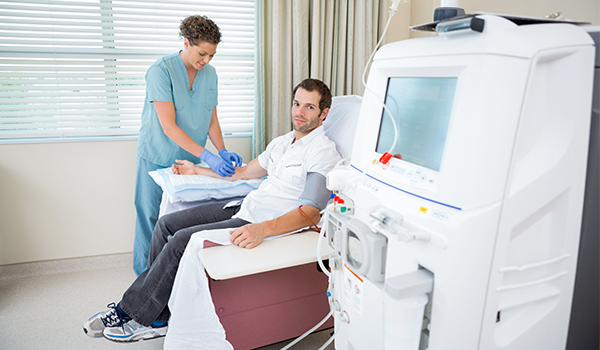Disaster Planning for Patients with Kidney Disease

It’s vital that people who have kidney disease are prepared for disaster situations that may interrupt their normal routine.
While COVID-19 has highlighted steps to take to stay safe during a pandemic, natural disasters are threats that require a different type of preparation and response. It remains important to have a conversation about planning for natural disasters with your patients who have chronic kidney disease, which often co-occurs with diabetes. This conversation can prepare them to maintain their health care routine during and after the disaster and avoid a life-threatening emergency.
In addition to planning tips for patients with diabetes, here are some extra points you can cover with your patients with kidney disease.
- If they receive dialysis in a center, they should contact the center to find out what it plans to do in case of disaster and where they should go if it closes.
- If they have a home hemodialysis machine, they should plan for how they will power it if the electricity is out and how to stop dialysis if they lose power in the middle of a treatment.
- If they use a continuous ambulatory peritoneal dialysis (CAPD) machine, they should know how to carry out CAPD manually. CAPD patients will need to have sufficient supplies available for at least two weeks while they remain at home. The fluids used for one day of ambulatory peritoneal dialysis by an adult weigh 18 pounds, so it is not practical for CAPD patients to take much fluid if they have to evacuate. Instead they will rely upon supplies obtained locally.
- All dialysis patients should keep a copy of their dialysis treatment plan in their information folder or notebook, or on their smart phones, along with the phone numbers of their dialysis center and other nearby centers, and the KERC toll-free number at 866-901-3773. This hotline can provide information on dialysis centers that are open.
- Advise them about what food to pack in their go-kit for the emergency renal 3-day diet. Having their own food is important because meals distributed at shelters can be very high in sodium and potassium. This eating plan can save a life if dialysis treatments are missed or delayed, because it reduces water and waste buildup in the body.
- Advise them to get their dialysis treatment ahead of schedule if a disaster is looming. Public health officials have learned from previous disasters that people with kidney disease who get early dialysis are less likely to need emergency services or hospital care.
- If your patients have hypertension, remind them how important it is for them to actively manage their blood pressure during a disaster. Disasters can be very stressful, which can exacerbate high blood pressure. They need to continue taking their blood pressure medications, restrict salt intake, focus on stress management, and maintain regular sleeping habits, to the extent possible.
Resources for Patients with Kidney Disease
- What to Do in an Emergency if You Need Dialysis (CDC)
- Weather and Natural Disasters: Help for Kidney Patients (National Kidney Foundation)
- Kidney Community Emergency Response Program
How do you help your patients prepare for disasters? Share below in the comments.

